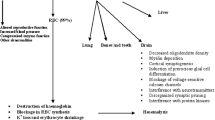Abstract
The influence of lead on sperm morphology, sister chromatid exchanges or on micronuclei formation was studied on male rabbits after exposure to doses of 0, 0.25, and 0.50 mg lead acetate/kg body weight subcutaneously injected three times a week during 14 weeks, each on a group of five rabbits. At the end of exposure phase the lead in blood concentrations of the three groups of rabbits were 0.32, 2.57, and 2.97 μmol/l respectively. The results did not show any evidence of treatment related effects on sperm count or on morphologic abnormalities of the sperms, neither on the histopathology of the testis. Statistical analysis of the number of sister chromatid exchanges per metaphase in lymphocytes indicated no differences between the groups. Also no dose dependent effect was observed on the relative number of micronuclei in bone marrow erythrocytes. The different susceptibility to lead in different organ systems of the rabbits was discussed.
Similar content being viewed by others
References
Bauchinger M, Schmid E, Einbrodt HJ, Dresp J (1976) Chromosome aberrations in lymphocytes after occupational exposure to lead and cadmium. Mutat Res 40: 57–62
Bauchinger M, Schmid E, Schmid D (1972) Chromosomenanalyse bei Verkehrspolizisten mit erhöhter Bleibelastung. Mutat Res 16: 407–412
Beatty RA, Napier RAN (1960) Genetics of gametes I. A quantitative analyses of five characteristics of rabbit spermatozoa. Proc R Soc Edinb [Nat Environ] 68: 1–16
Bijlsma JB, de France HF (1976) Cytogenetic investigations in volunteers ingesting inorganic lead. Int Arch Occup Environ Health 38: 145–148
Deknudt G, Manuel Y, Gerber GB (1977) Chromosomal aberrations in workers professionally exposed to lead. J Toxicol Environ Health 3: 885–891
Forni A, Sciame A, Bertazzi A, Alessio L (1980) Chromosome and biochemical studies in women occupationally exposed to lead. Arch Environ Health 35: 139–146
Forni A, Cambiaghi G, Secchi GC (1976) Initial occupational exposure to lead. Arch Environ Health 31: 73–78
Gäth J, Thiess AM (1972) Chromosomen-Untersuchungen bei Chemiearbeitern. Zentralbl Arbeitsmed Arbeitsschutz Prophyl 12: 357–362
Gerber GB, Leonard A, Jacquet P (1980) Toxicity, mutagenicity and teratogenicity of lead. Mutat Res 76: 115–141
Hancock JL (1957) The morphology of boar spermatozoa. J R Micros Soc 76: 84–97
Lancranjan I, Popescu HI, Gavanescu O, Klepsch I, Serbanescu M (1975) Reproductive ability of workmen occupationally exposed to lead. Arch Environ Health 30: 396–401
Mäki-Paakkanen J, Sorsa M, Vainio H (1981) Chromosome aberrations and sister chromatid exchanges in lead-exposed workers. Hereditas 94: 269–275
Nordenson I, Beckman G, Beckman L, Nordström S (1978) Occupational and environmental risks in and around a smelter in Northern Sweden. Hereditas 88: 263–267
O'Riordan ML, Evans HJ (1974) Absence of significant chromosome damage in males occupationally exposed to lead. Nature 247: 50–53
Potter WL, Upton PC, Dunn BL (1979) Morphological changes as observed by light microscopy of the acrosome of boar spermatozoa subjected to deep freezing. J Biol Sci 32: 575–579
Schwanitz G, Gebhart E, Rott HD, Schaller K-H, Essing H-G, Lauer O, Prestele H (1975) Chromosomenuntersuchungen bei Personen mit beruflicher Bleiexposition. Dtsch Med Wochenschr 100: 1007–1011
Schwanitz G, Lehnert G, Gebhart E (1970) Chromosomenschäden bei beruflicher Bleibelastung. Dtsch Med Wochenschr 95: 1636–1641
Spit BJ, Wibowo AAE, Feron VJ, Zielhuis RL (1981) Ultrastructural changes in the kidneys of rabbits treated with lead acetate. Arch Toxicol (Berl) (in press)
Wibowo AAE, Zielhuis RL (1980) Different effects on hemesynthesis in male and female rabbits treated with lead acetate. Arch Toxicol (Berl) 45: 67–73
World Health Organization Study Group (1980) Recommended health-based limits in occupational exposure to heavy metals. WHO Tech Report Series 647, Geneva
Wulf HC (1980) Sister chromatid exchange in human lymphocytes exposed to nickel and lead. Dan Med Bull 27: 40–42
Unnithan RR (1976) A rapid single-step stain for mammalian spermatozoa. Indian J Exp Biol 14: 611–613
Author information
Authors and Affiliations
Rights and permissions
About this article
Cite this article
Willems, M.I., de Schepper, G.G., Wibowo, A.A.E. et al. Absence of an effect of lead acetate on sperm morphology, sister chromatid exchanges or on micronuclei formation in rabbits. Arch Toxicol 50, 149–157 (1982). https://doi.org/10.1007/BF00373397
Received:
Issue Date:
DOI: https://doi.org/10.1007/BF00373397




